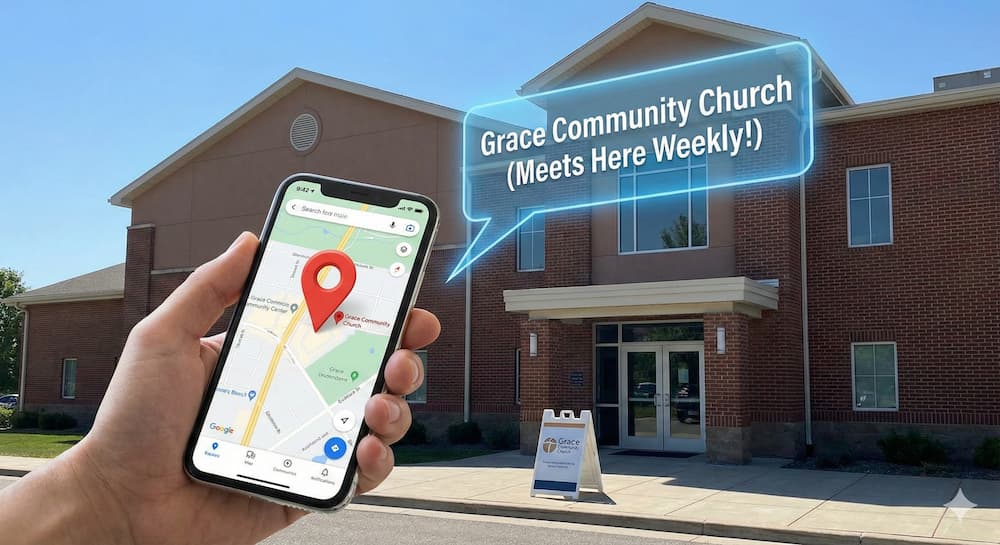Why Churches Should Be Eco Friendly
The massive financial benefit that come from being mindful of your church’s ecological fingerprint.

Let's talk about why churches are becoming eco-friendly and why that's paying off financially. The caveat here is there are lots of ways for churches to go eco-friendly. They can put in better lighting. They can use power outlets that shut off automatically. They can put in smart switches and a smart thermostat. They can put in better windows. There are so many ways.
Today we're going to talk about one specific example, which is the church bulletin. Most churches—300 plus thousand churches in the US—prints a bulletin. For some churches, the bulletin is sacred ground. It has to be a certain way, there's a certain person that does it, and there’s internal fighting to get content on the bulletin. The bulletin's a big deal. But for a long time, the bulletin has been the way churches communicate their announcements, their events, their birth announcements, and their death announcements.
The problem is: we've evolved. Now we have mobile phones. When the bulletin was invented, the mobile phone didn't exist. So churches pay a lot of money to print bulletins. A large church in Los Angeles uses Tithe.ly—a fairly large church. Before they used Tithe.ly, they would print 500 beautiful color bulletins every week, and they’ve done it for decades. The bulletin has been part of what they do. It was a beautiful bulletin. When we first thought it, we were struck by how beautiful it was. But as we’ve talked with them about giving technology, we said: "You know, you can put your whole bulletin in your custom church app."
Let's just talk about the impact and how it pays off. If you're printing 500 bulletins, you’re paying 25 cents per bulletin. These were nice. That would be $6,500 per year. When I visit a church that uses bulletins, I see the bulletins get put on seats and I'd leave church and I bet you at least half of them were still on the seats. People weren't taking them and the half that were being brought home to be thrown in the garbage later.
The bulletin isn't being actively used by people heavily nowadays. They're getting their information in different ways. This is an opportunity for the church to go digital. The Los Angeles church we were talking to ended up minimizing their bulletin printing to 50 bulletins per week, and directing the rest of their members to use the mobile app, which alone saved them $6,000 per year.
They print 50 bulletins a week for the people that really want the bulletin and set it in the lobby when you're walking in. If you want one, you grab one and 50's the perfect number for them. They've taken the whole bulletin and put it in their app. The whole congregation downloads the mobile app. They get push notifications when relevant items are updated. The digital bulletin is such a better way. It's in the app. Now the church uses push notifications. The church uses text messages. The church gets people back in the app.
You can register for the events in the bulletin by pushing a button right next to the event. You don't have to look at the bulletin and then go to the website.
I can register for events right in the app. I can take notes right in the app. I can submit prayer requests right in the app. Lots of things that happened in the bulletin can happen right in the app and it's more interactive, it's in real-time, and it's right in my hands. That's one way that churches can go eco-friendly. I'm printing less. I'm killing fewer trees. I'm actually saving money, and I'm meeting my members and my visitors where they're at, because they all walked into the church with their mobile phone.
Sign Up for Product Updates
Let's talk about why churches are becoming eco-friendly and why that's paying off financially. The caveat here is there are lots of ways for churches to go eco-friendly. They can put in better lighting. They can use power outlets that shut off automatically. They can put in smart switches and a smart thermostat. They can put in better windows. There are so many ways.
Today we're going to talk about one specific example, which is the church bulletin. Most churches—300 plus thousand churches in the US—prints a bulletin. For some churches, the bulletin is sacred ground. It has to be a certain way, there's a certain person that does it, and there’s internal fighting to get content on the bulletin. The bulletin's a big deal. But for a long time, the bulletin has been the way churches communicate their announcements, their events, their birth announcements, and their death announcements.
The problem is: we've evolved. Now we have mobile phones. When the bulletin was invented, the mobile phone didn't exist. So churches pay a lot of money to print bulletins. A large church in Los Angeles uses Tithe.ly—a fairly large church. Before they used Tithe.ly, they would print 500 beautiful color bulletins every week, and they’ve done it for decades. The bulletin has been part of what they do. It was a beautiful bulletin. When we first thought it, we were struck by how beautiful it was. But as we’ve talked with them about giving technology, we said: "You know, you can put your whole bulletin in your custom church app."
Let's just talk about the impact and how it pays off. If you're printing 500 bulletins, you’re paying 25 cents per bulletin. These were nice. That would be $6,500 per year. When I visit a church that uses bulletins, I see the bulletins get put on seats and I'd leave church and I bet you at least half of them were still on the seats. People weren't taking them and the half that were being brought home to be thrown in the garbage later.
The bulletin isn't being actively used by people heavily nowadays. They're getting their information in different ways. This is an opportunity for the church to go digital. The Los Angeles church we were talking to ended up minimizing their bulletin printing to 50 bulletins per week, and directing the rest of their members to use the mobile app, which alone saved them $6,000 per year.
They print 50 bulletins a week for the people that really want the bulletin and set it in the lobby when you're walking in. If you want one, you grab one and 50's the perfect number for them. They've taken the whole bulletin and put it in their app. The whole congregation downloads the mobile app. They get push notifications when relevant items are updated. The digital bulletin is such a better way. It's in the app. Now the church uses push notifications. The church uses text messages. The church gets people back in the app.
You can register for the events in the bulletin by pushing a button right next to the event. You don't have to look at the bulletin and then go to the website.
I can register for events right in the app. I can take notes right in the app. I can submit prayer requests right in the app. Lots of things that happened in the bulletin can happen right in the app and it's more interactive, it's in real-time, and it's right in my hands. That's one way that churches can go eco-friendly. I'm printing less. I'm killing fewer trees. I'm actually saving money, and I'm meeting my members and my visitors where they're at, because they all walked into the church with their mobile phone.
podcast transcript
Let's talk about why churches are becoming eco-friendly and why that's paying off financially. The caveat here is there are lots of ways for churches to go eco-friendly. They can put in better lighting. They can use power outlets that shut off automatically. They can put in smart switches and a smart thermostat. They can put in better windows. There are so many ways.
Today we're going to talk about one specific example, which is the church bulletin. Most churches—300 plus thousand churches in the US—prints a bulletin. For some churches, the bulletin is sacred ground. It has to be a certain way, there's a certain person that does it, and there’s internal fighting to get content on the bulletin. The bulletin's a big deal. But for a long time, the bulletin has been the way churches communicate their announcements, their events, their birth announcements, and their death announcements.
The problem is: we've evolved. Now we have mobile phones. When the bulletin was invented, the mobile phone didn't exist. So churches pay a lot of money to print bulletins. A large church in Los Angeles uses Tithe.ly—a fairly large church. Before they used Tithe.ly, they would print 500 beautiful color bulletins every week, and they’ve done it for decades. The bulletin has been part of what they do. It was a beautiful bulletin. When we first thought it, we were struck by how beautiful it was. But as we’ve talked with them about giving technology, we said: "You know, you can put your whole bulletin in your custom church app."
Let's just talk about the impact and how it pays off. If you're printing 500 bulletins, you’re paying 25 cents per bulletin. These were nice. That would be $6,500 per year. When I visit a church that uses bulletins, I see the bulletins get put on seats and I'd leave church and I bet you at least half of them were still on the seats. People weren't taking them and the half that were being brought home to be thrown in the garbage later.
The bulletin isn't being actively used by people heavily nowadays. They're getting their information in different ways. This is an opportunity for the church to go digital. The Los Angeles church we were talking to ended up minimizing their bulletin printing to 50 bulletins per week, and directing the rest of their members to use the mobile app, which alone saved them $6,000 per year.
They print 50 bulletins a week for the people that really want the bulletin and set it in the lobby when you're walking in. If you want one, you grab one and 50's the perfect number for them. They've taken the whole bulletin and put it in their app. The whole congregation downloads the mobile app. They get push notifications when relevant items are updated. The digital bulletin is such a better way. It's in the app. Now the church uses push notifications. The church uses text messages. The church gets people back in the app.
You can register for the events in the bulletin by pushing a button right next to the event. You don't have to look at the bulletin and then go to the website.
I can register for events right in the app. I can take notes right in the app. I can submit prayer requests right in the app. Lots of things that happened in the bulletin can happen right in the app and it's more interactive, it's in real-time, and it's right in my hands. That's one way that churches can go eco-friendly. I'm printing less. I'm killing fewer trees. I'm actually saving money, and I'm meeting my members and my visitors where they're at, because they all walked into the church with their mobile phone.
VIDEO transcript
Let's talk about why churches are becoming eco-friendly and why that's paying off financially. The caveat here is there are lots of ways for churches to go eco-friendly. They can put in better lighting. They can use power outlets that shut off automatically. They can put in smart switches and a smart thermostat. They can put in better windows. There are so many ways.
Today we're going to talk about one specific example, which is the church bulletin. Most churches—300 plus thousand churches in the US—prints a bulletin. For some churches, the bulletin is sacred ground. It has to be a certain way, there's a certain person that does it, and there’s internal fighting to get content on the bulletin. The bulletin's a big deal. But for a long time, the bulletin has been the way churches communicate their announcements, their events, their birth announcements, and their death announcements.
The problem is: we've evolved. Now we have mobile phones. When the bulletin was invented, the mobile phone didn't exist. So churches pay a lot of money to print bulletins. A large church in Los Angeles uses Tithe.ly—a fairly large church. Before they used Tithe.ly, they would print 500 beautiful color bulletins every week, and they’ve done it for decades. The bulletin has been part of what they do. It was a beautiful bulletin. When we first thought it, we were struck by how beautiful it was. But as we’ve talked with them about giving technology, we said: "You know, you can put your whole bulletin in your custom church app."
Let's just talk about the impact and how it pays off. If you're printing 500 bulletins, you’re paying 25 cents per bulletin. These were nice. That would be $6,500 per year. When I visit a church that uses bulletins, I see the bulletins get put on seats and I'd leave church and I bet you at least half of them were still on the seats. People weren't taking them and the half that were being brought home to be thrown in the garbage later.
The bulletin isn't being actively used by people heavily nowadays. They're getting their information in different ways. This is an opportunity for the church to go digital. The Los Angeles church we were talking to ended up minimizing their bulletin printing to 50 bulletins per week, and directing the rest of their members to use the mobile app, which alone saved them $6,000 per year.
They print 50 bulletins a week for the people that really want the bulletin and set it in the lobby when you're walking in. If you want one, you grab one and 50's the perfect number for them. They've taken the whole bulletin and put it in their app. The whole congregation downloads the mobile app. They get push notifications when relevant items are updated. The digital bulletin is such a better way. It's in the app. Now the church uses push notifications. The church uses text messages. The church gets people back in the app.
You can register for the events in the bulletin by pushing a button right next to the event. You don't have to look at the bulletin and then go to the website.
I can register for events right in the app. I can take notes right in the app. I can submit prayer requests right in the app. Lots of things that happened in the bulletin can happen right in the app and it's more interactive, it's in real-time, and it's right in my hands. That's one way that churches can go eco-friendly. I'm printing less. I'm killing fewer trees. I'm actually saving money, and I'm meeting my members and my visitors where they're at, because they all walked into the church with their mobile phone.












.jpeg)





.jpg)









